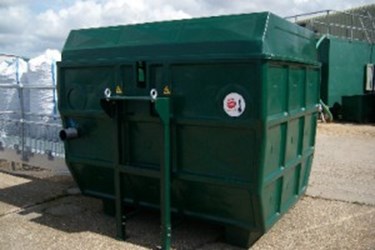WPL Miranda Rotating Biological Contactor (RBC) Makes UK Wastewater Debut

- Next generation rotating biological contactor (RBC) technology arrives in the UK
- Modular system offers flexibility and much lower power consumption
- WPL adds RBC technology to its portfolio of treatment systems
- RBC modules can be supplied with primary and final settlement options
- Flexible pricing options and hire
- Trial process before purchase
- Above or below ground installation
Wastewater treatment specialist WPL has brought a highly efficient rotating biological contactor (RBC) to the UK municipal market for the first time. The WPL Miranda RBC, which is manufactured to German design standards, has been available internationally for the last five years, but an exclusive UK distribution agreement was recently signed with WPL.
WPL’s Sales & Marketing Director, Simon Kimber, said, “This next generation RBC technology utilises solid shafts designed to overcome any issues with shaft failure, resulting in lower whole-life costs for utilities. Its flexible modular design means that it can be configured to serve communities ranging from 100 upwards population equivalent.”
In WPL’s Miranda RBC secondary treatment system, disks are connected to a shaft and slowly rotated by means of a motor. Each rotating disc spends 40% of its time in the wastewater and 60% in contact with air.
Repetitive rotation allows the discs to accumulate micro-organisms, which use the available oxygen to convert the pollutants in the wastewater into carbon dioxide and water. Simon Kimber says that the WPL Miranda is a significant step-up from RBCs previously available in the UK.
“Not only do the discs rotate faster,” he says, “the innovative design has turned the traditional disc system around by 90 degrees, so that the flow runs through the rotating discs rather than along them. This increases the surface area of media per square metre and the contact time between the bacteria and the settled sewage, increasing the efficiencies of the process.
“The result is final treated effluent which exceeds the EU standards for discharge and can be safely released into the environment.”
The modular design of the WPL Miranda RBC makes it possible to increase capacity by adding discs or modules. It is also possible to bypass specified modules to reduce capacity and save energy. The packaged units are easy to transport and install – reducing onsite health and safety risks – and can operate in series or in parallel.
Furthermore the WPL Miranda RBC has been subjected to rigorous FEA analysis which confirms compliance with all water utilities specifications.
The UK’s RBC market for utilities is estimated at £10 million per annum, and Simon Kimber believes there is significant opportunity for WPL to take a share of this and increase its client base.
“We have responded effectively to our customers’ requirements and introduced an improvement to what is currently available in the UK market,” he says. “The WPL Miranda RBC is next generation technology, our competitors are only offering first or second generation. We have recognised marketplace demands and strengthened our portfolio accordingly.”
WPL Ltd requested TriVista Engineering Ltd to carry out Finite Element Analysis on the WPL Miranda RBC to test the structural integrity of the tank. The results of the FEA testing indicates a minimum of 25 years long life.
Source: WPL
